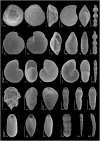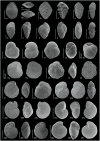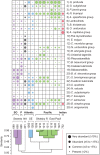Early Eocene deep-sea benthic foraminiferal faunas: Recovery from the Paleocene Eocene Thermal Maximum extinction in a greenhouse world
- PMID: 29474429
- PMCID: PMC5825042
- DOI: 10.1371/journal.pone.0193167
Early Eocene deep-sea benthic foraminiferal faunas: Recovery from the Paleocene Eocene Thermal Maximum extinction in a greenhouse world
Abstract
The early Eocene greenhouse world was marked by multiple transient hyperthermal events. The most extreme was the Paleocene-Eocene Thermal Maximum (PETM, ~56 Ma), linked to the extinction of the globally recognised deep-sea benthic foraminiferal Velasco fauna, which led to the development of early Eocene assemblages. This turnover has been studied at high resolution, but faunal development into the later early Eocene is poorly documented. There is no widely accepted early Eocene equivalent of the Late Cretaceous-Paleocene Velasco fauna, mainly due to the use of different taxonomic concepts. We compiled Ypresian benthic foraminiferal data from 17 middle bathyal-lower abyssal ocean drilling sites in the Pacific, Atlantic and Indian Oceans, in order to characterise early Eocene deep-sea faunas by comparing assemblages across space, paleodepth and time. Nuttallides truempyi, Oridorsalis umbonatus, Bulimina trinitatensis, the Bulimina simplex group, the Anomalinoides spissiformis group, pleurostomellids, uniserial lagenids, stilostomellids and lenticulinids were ubiquitous during the early Eocene (lower-middle Ypresian). Aragonia aragonensis, the Globocassidulina subglobosa group, the Cibicidoides eocaenus group and polymorphinids became ubiquitous during the middle Ypresian. The most abundant early Ypresian taxa were tolerant to stressed or disturbed environments, either by opportunistic behavior (Quadrimorphina profunda, Tappanina selmensis, Siphogenerinoides brevispinosa) and/or the ability to calcify in carbonate-corrosive waters (N. truempyi). Nuttallides truempyi, T. selmensis and other buliminids (Bolivinoides cf. decoratus group, Bulimina virginiana) were markedly abundant during the middle Ypresian. Contrary to the long-lived, highly diverse and equitable Velasco fauna, common and abundant taxa reflect highly perturbed assemblages through the earliest Ypresian, with lower diversity and equitability following the PETM extinction. In contrast, the middle Ypresian assemblages may indicate a recovering fauna, though to some extent persistently disturbed by the lower-amplitude Eocene hyperthermals (e.g., Eocene Thermal Maximum 2 and 3). We propose the name 'Walvis Ridge fauna' for future reference to these Ypresian deep-sea benthic foraminiferal assemblages.
Conflict of interest statement
Figures










Similar articles
-
The Impact of the Latest Danian Event on Planktic Foraminiferal Faunas at ODP Site 1210 (Shatsky Rise, Pacific Ocean).PLoS One. 2015 Nov 25;10(11):e0141644. doi: 10.1371/journal.pone.0141644. eCollection 2015. PLoS One. 2015. PMID: 26606656 Free PMC article.
-
Little lasting impact of the Paleocene-Eocene Thermal Maximum on shallow marine molluscan faunas.Sci Adv. 2018 Sep 5;4(9):eaat5528. doi: 10.1126/sciadv.aat5528. eCollection 2018 Sep. Sci Adv. 2018. PMID: 30191179 Free PMC article.
-
Resilience of marine invertebrate communities during the early Cenozoic hyperthermals.Sci Rep. 2020 Feb 7;10(1):2176. doi: 10.1038/s41598-020-58986-5. Sci Rep. 2020. PMID: 32034228 Free PMC article.
-
Bird evolution in the Eocene: climate change in Europe and a Danish fossil fauna.Biol Rev Camb Philos Soc. 2006 Nov;81(4):483-99. doi: 10.1017/S146479310600707X. Epub 2006 Aug 8. Biol Rev Camb Philos Soc. 2006. PMID: 16893476 Review.
-
Evidence for rapid climate change in the Mesozoic-Palaeogene greenhouse world.Philos Trans A Math Phys Eng Sci. 2003 Sep 15;361(1810):1885-916; discussion 1916. doi: 10.1098/rsta.2003.1240. Philos Trans A Math Phys Eng Sci. 2003. PMID: 14558900 Review.
Cited by
-
Cenozoic climatic changes drive evolution and dispersal of coastal benthic foraminifera in the Southern Ocean.Sci Rep. 2021 Oct 6;11(1):19869. doi: 10.1038/s41598-021-99155-6. Sci Rep. 2021. PMID: 34615927 Free PMC article.
-
Towards understanding paleoclimate impacts on primate de novo genes.G3 (Bethesda). 2023 Aug 30;13(9):jkad135. doi: 10.1093/g3journal/jkad135. G3 (Bethesda). 2023. PMID: 37313728 Free PMC article.
References
-
- Snider LJ, Burnet BR, Hessler RR. The composition and distribution of meiofauna and nanobiota in a central North Pacific deep-sea area. Deep-Sea Research Part I 1984; 31: 1225–1249.
-
- Gooday AJ, Levin LA, Linke P, Heeger T. The role of benthic foraminifera in deep-sea food webs and carbon cycling In: Rowe GT, Pariente V, editors. Deep-Sea Food Chains and the Global Carbon Cycle. Dordrecht: Kluwer Academic Publishers; 1992. pp. 63–91.
-
- Gooday AJ, Bett BJ, Shires R, Lambshead PJD. Deep-sea benthic foraminiferal species diversity in the NE Atlantic and NW Arabian Sea: a synthesis. Deep-Sea Research Part II 1998; 45: 165–201.
-
- Verity PG, Smetacek V, Smayda T. Status, trends and the future of the marine pelagic ecosystem. Environmental Conservation 2002; 29: 207–237. 10.1017/S0376892902000139 - DOI
-
- Katz ME, Wright JD, Katz DR, Miller KG, Pak DK, Shackleton NJ, et al. Early Cenozoic benthic foraminiferal isotopes: species reliability and interspecies correction factors. Paleoceanography 2003; 18: 1024 10.1029/2002PA000798 - DOI
Publication types
MeSH terms
LinkOut - more resources
Full Text Sources
Other Literature Sources

